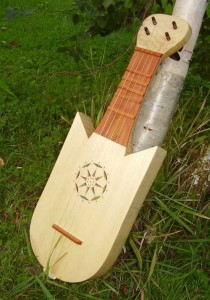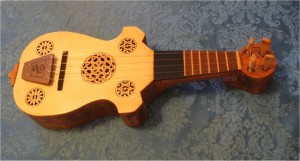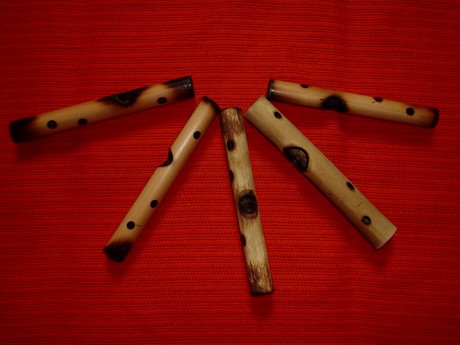Citola / Citole / Sytole / Cytiole / Gytolle


Citole
From Wikipedia, the free encyclopedia
Citole, also spelled Sytole, Cytiole, Gytolle, etc. (probably a French diminutive form of cithara, and not from Latin cista, a box), an archaic musical instrument of which the exact form is uncertain. It is generally shown as a four-string instrument, with a body generally referred to as "holly-leaf" shaped. There is a surviving instrument from around 1300 from Warwick Castle which is now in the British Museum, albeit at some point in antiquity converted into a violin with tall bridge, 'f'-holes and angled fingerboard - thus the image below of the instrument's top is not representative of its original appearance.
British Museum example, from side
It is frequently mentioned by poetical writers of the 13th to the 15th centuries, and is found in Wycliffes Bible (1360) in 2 Samuel vi. 5, Harpis and sitols and tympane. The Authorized Version has psaltiries, and the Vulgate lyrae. It has been supposed to be another name for the psaltery, a box-shaped instrument often seen in the illuminated missals of the Middle Ages.
|
The Citole
Housed in the British Museum is one of the most extraordinary extant medieval instruments. Dating from the early fourteenth century, this is the only surviving citole, a type of plucked instrument. Its edges are covered with intricate carvings depicting woodland scenes with real and imaginary creatures. This particular instrument was modified in the sixteenth century, and turned into a violin for Queen Elizabeth I. Thus the soundboard, fingerboard, and other fittings all postdate the Middle Ages. The body, however, is original and remarkably unscathed. My citole is copied from the original, which I have been able to study in detail. In making this reproduction, I sought to approximate the body shape as nearly as I could, restoring obvious alterations. There are still many unknowns, such as the thickness of the walls, which hopefully will be illuminated by further scientific study. The original fittings and set-up have been lost, of course, so my reproduction represents my best understanding of these at this time. Fingerboard, Bridge, and Frets Further Developments and Citole News The citole is a little understood latecomer to the early music revival. Part of its difficulty comes from a lack of a clear idea of what a citole is. Fortunately, with the survival of the British Museum Citole, we have an example of one thing which a citole might be. However, judging from surviving iconography, instruments of many shapes and characteristics were all called citoles. Thus any problem that we have identifying them is not merely something of the twentieth century, but is a result of an ambiguous definition in the middle ages. However, a good working definition would be that a citole is a plucked stringed instrument, popular in Europe roughly 1200-1400 (with numerous regional fluctuations in popularity), which has a short neck and which does not have a rounded body. Rounded body instruments fall into the category of lutes and gitterns. Anything else (?!) may be called a citole. One difficulty we have to deal with is that for much of the twentieth century the nomenclature of citoles and gitterns has been confused. In a 1977 article in the Galpin Society Journal, Laurence Wright matched the correct instrument back with its correct name. Essentially, a gittern has a rounded back and body, like a small lute, while a citole can have a variety of shapes. It is only within the past year that the citole in the British Museum has been displayed as a citole rather than a gittern. Nomenclature aside, part of the legitimate confusion about the citole is that medieval citoles had a wide variety of characteristics in iconography. Defining the citole as a plucked instrument with a distinct neck and body, as opposed to the rounded shape of the gittern, includes a wide array of instruments. Body shape varies from a pointy holly leaf shape to a rounded guitar shape, with countless variations between them. The unusual tapered body with a thumbhole that the surviving instrument has can be seen distinctly in some carvings and drawings, but so can a simpler 'fiddle' construction, with a flat back and simple neck. Most iconographic sources do not have enough detail to tell much about their construction. The majority of citole reconstructions made in the past 30 years have been fiddle-type citoles rather than thumbhole-type citoles. Aspects such as tuning and repertoire, even string material, plectra, and fretting, are still largely unanswered questions, awaiting the concerted efforts of modern scholars, builders, and players to find what works in practice. The citole appears frequently in medieval artwork. It can be found adorning cathedral doorways and margins of manuscripts. These samples of iconography show the variety of features.
Tickhill Psalter, c. 1303-1313; Guitar shaped citole with thumbhole Lincoln Cathedral, c. 1275, Fiddle-type citole with neck and peg disk A Peterborough Psalter in Oxford, early 14th c; small dragon-headed citole
Peterborough Psalter c. 1299-1315; Holly leaf citole with dragon head on long neck
Robert De Lisle Psalter, 1330s; Citole with thumbhole and dragon head. My reconstruction: The British Museum citole was made from a giant piece of boxwood. Unfortunately, box trees do not grow that large anymore, so I used maple instead. The entire body- back, sides, and neck- is made from one piece of wood. It has a keel-shaped back, with a central ridge extending towards the pegbox. The opposite end has a trefoil-shaped extension, which provides a convenient rest on your arm.
The British Museum citole currently bears an anachronistic violin top. While the violin soundboard is important for many reasons, it bears no resemblance to the soundboard which the citole originally had. The violin soundboard is carved into a vaulted shape; were it to be taken off, it would sit flat on a table and arch away from the table in the center. However, I believe that the original soundboard was a flat piece of wood bent to shape. It is apparent upon examining the ribline on the surviving boxwood body that it originally accommodated such a bent top, and parts of it have been lowered to accept the current arched top.
The number, shape, and size of soundholes vary in iconographic representations. For this instrument, I chose to copy, among others, the De Lisle citole, which has a large central rose. I took the pattern for the rose from the carvings on the Winchester choir stalls, which were made by a Norwich mason in 1308.
One alteration which has been made to the original citole in the British Museum is the reconfiguring of the pegs. When it was converted into a violin, it was given lateral pegs and a pegbox, like a violin. However, traces remain of two plugged holes directly in front of the dragon's mouth, which lead me to believe that originally the citole had frontal pegs. The existing holes and remaining space indicated that the citole originally had six strings. Since the neck is too narrow to accommodate six individual strings, I paired them into three courses. I currently have the instrument tuned in fifths, D-A-E, although tunings of a fifth and a fourth, or all fourths, work equally well to meet the needs of the performer. BM citole head showing plugged holes for frontal citole pegs
My reconstruction with frontal pegs
Fingerboard, Bridge, and Frets The neck of the BM Citole rises above the top rib line by about 1.0 cm (although this area shows signs of being tampered with, I believe that there was always a significant rise above the soundboard). The rise indicates that the fingerboard was higher than the soundboard, and that the bridge was also higher than we normally consider plucked-stringed instrument bridges to be. However, some carvings, most noticeably the citole in Lincoln Cathedral, have high bridges. I placed the bridge at the point of the body where the outline curve changes from convex to concave. This point is also 1/3 of the total length.
Some iconographic citoles have tailpieces, while on others the strings attach directly in the trefoil area. The British Museum citole had some kind of large, tapered hole at the base of the trefoil, as does the DeLisle Psalter citole. A peg could have stuck through this hole, and the strings wrapped around it, or somehow the strings were secured within the hole. On my reproduction, I took the simple method of using a tailpiece and looping tailgut around the base of the trefoil, as is done in the Peterborough Psalter.
Nearly all reliable pictures of citoles show frets. With the neck/thumbhole configuration, tying frets would be impossible, so I made wooden frets. The number of frets varies on iconography, but I put on seven chromatic frets, to fill in the fifth between strings. I tuned them to 1/3 comma meantone. (A compromise, admittedly)
Further Developments and Citole News Overall, I am quite happy with how my citole has turned out. It has a wonderful, bright timbre which carries well. The shape of the body and neck, so intimidatingly strange, fits comfortably in ones arms. However, there are aspects to it which I am curious about experimenting with. Some of these are setup issues, such as bridge placement, frets, tuning, and fingerboard height. Another issue is one of size: while this is the size of the surviving instrument, iconographic sources depict citoles of this size and larger. My current plans involve designing a larger instrument with four courses, intended to reach the C below middle C. The bridge placement will be lower on the instrument, and fingerboard flat against the belly, resulting in a lower string height. I hope to have the first of these instruments completed by summer 2006. Update August 2006: the large citole is strung up and playable, though yet unfinished. Pictures coming soon. The British Museum is in the process of performing scientific examinations on the instrument. With the detailed information this will reveal, I would like to build a closer copy. The British Museum citole was the subject of a Masters Thesis which I wrote at the University of Minnesota. Treating that particular instrument as the subject, the thesis considers its origins (East Anglia in the early fourteenth century) using art historical and social evidence. It then continues to trace as closely as possible what has happened to the instrument over its 700 year life. The thesis, "Retelling the Story of the English Gittern in the British Museum: An Organological Study, ca. 1300 - Present," by Kathryn E Buehler, 2002, is available through Interlibrary Loan. The British Museum is planning to hold a symposium on the citole within the next few years. Watch this space for updates. A woodcut of my citole, done by Paul Schumann Prints (9"x18") are available for $75.
Thanks for visiting! Kate Buehler-McWilliams, © 2005 Back to "Unprofitable Instruments"
|
[edit] External links
- [1] - Great deal of research work on the citole and its development.














